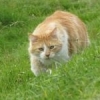The Garrett article actually makes sense in a counter intuitive way. When an object breaks the sound barrier, air is compressed in front of it. This is why supersonic aircraft (and high velocity bullets) are designed with sleek, pointy noses and profiles to move as smoothly as possible through the air. Looking at a Remington 405 gr. JSP .45-70 cartridge from a box that accompanied the 1894 Government Model Trapdoor Springfield that my late father-in-law gifted me shortly before he passed, it has a flat point about 1/4" across. Even with a round nose, it would not be the best design for supersonic flight.
My thought is that the faster a projectile like that goes beyond the sound barrier, the denser that "bow wave" will be. It's possible that as the bullet reaches the target, that region of compressed air hits first and reacts with a counter force that acts as a brake on velocity. This is strictly supposition and to test would likely need a laboratory with Doppler radar such as Hornady used in developing the heat resistant tips for their ELD bullets.
Regardless, getting the attention of a heavily muscled, bulky animal, requires a solid bullet that can punch through tough tissue and/or break bones. It needs to be fired from a weapon that you can shoot enough to develop proficiency for good bullet placement and can physically pack comfortably. Those two are limiting factors for me due to rheumatoid arthritis and fibromyalgia. I can empty a 20 round magazine of 150 gr. .308 from my M-1A Socom 16 without a hitch, but two or three of the same rounds from a bolt action are going to be reminding me of their kick for a day or two. Too much of that will have me visiting Virginia Mason for shoulder reconstruction, and I already carry enough aftermarket parts from the waist down, I'd like to keep the remaining OEM parts functional for as long as possible!


